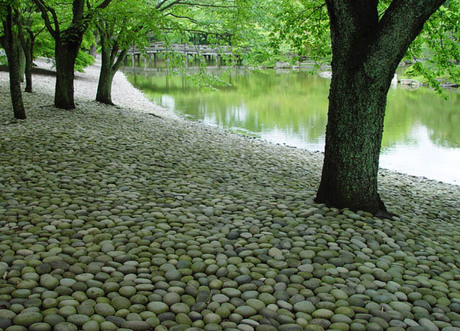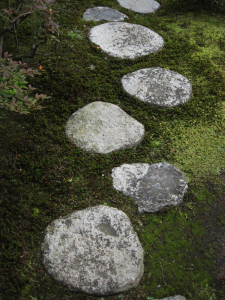Finally spring is here. Temperatures today were in the 70’s. Low tonight in the 40’s. I’ve finally turned off my heat.
Most everything in the garden is showing signs of life.

Here’s my ‘to do list’ for the next day or two…
1) Leigh – ask to borrow his seiza bench for Ron
2) Shim up arbor which fell down with hurricane Sandy
3) Clean out tuskubai (water basin)
4) Retie fence with black twine
4) Mulch woodland bed
5) Trim grass around beds
6) Get the umbrella out from the basement to put on porch table
7) Candle both J. Pines
8) Photograph porch bed so in the fall will know where to plant blubs
9) Next year make sure to prune willow by fence
10) More woodland phlox in the outer roji –
…and on it goes.
Making a garden is no small thing nor is it one big ‘fix’. It takes years of living day to day, thinking about it and asking questions:
Stones are priceless in Japan. I”ve seen gardens created in the 16th century that have stones and rocks imported from far away that are worth their weight in gold. Seriously. It”s part of the statement of a lord or king”s garden – or in Japan”s case – the Shogun”s garden. Just look at Versailles if you can”t travel to the east. It”s the same mentality.
I shy away from that sort of thing and rely on what is near at hand with only a suggestion of intent – not of wealth and power – but of a turning inward and coming back to a sense of self amidst the ordinary.
However, I can”t help but be in awe of this place:

When Okubo Tadazane, lord of Odawara (present-day Kanagawa Prefecture) sent thousands of fist-sized rounded beach stones to Emperor Kokaku for his garden in 1815, each one came wrapped individually in silk cloth.
 The Tea garden, or Roji is divided into two spaces: an outer garden and an inner garden connected by a series of stone paths. Gates and fences play an important role in dividing the two rooms to create the feeling of transition from one place to another.
The Tea garden, or Roji is divided into two spaces: an outer garden and an inner garden connected by a series of stone paths. Gates and fences play an important role in dividing the two rooms to create the feeling of transition from one place to another.
When designing the landscape for a Tea garden I start by looking at the architecture of the place, the bones and details, because I want to gracefully transition from outer to inner, from the street to the tea house; a transition from daily life to a space that is contemplative and feels connected to place.
It is not necessary to have a tea house or retreat space in your back yard, but the garden should feel like you’ve stepped onto a path that leads you through the countryside to a rustic hut or space designed for quiet contemplation and reflection.
The overall impression should be one of integrity, tranquility and beauty. There are a few elements that make this work.
-excerpt from A Tea Garden in Tivoli










